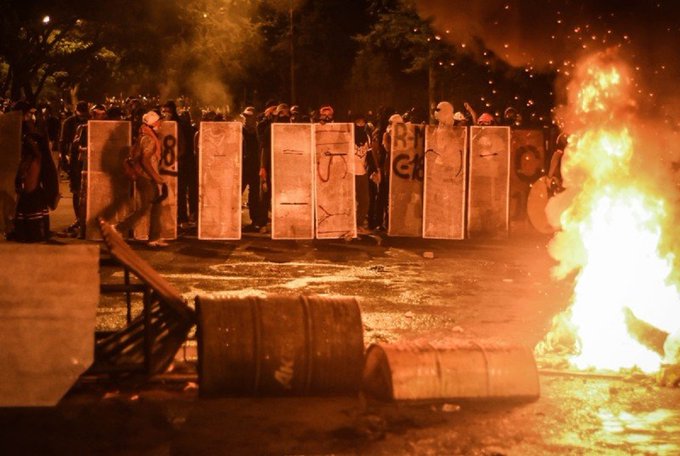Colombia. May 9. 2021. The National Strike is now in its 12th day. The social explosion unleashed by the project of a new Tax Reform in the country has left the streets full of people painting, dancing and shouting “No More” to the failed government of Iván Duque and the policies of death and violence that have been implemented, and which have worsened during these days of social mobilization.
Originally published by Colombia Informa. Translated by Riot Turtle.
Police violence, militarization and State terrorism is the sad balance that these days have brought us, but they do not blur the resistance or diminish the horizon of the demonstrations in the country.
Popular neighborhoods organize
Such massive mobilizations have not been seen since the National Strike of November 2019, where various sectors of society came together. However, this time the mobilization has been decentralized compared to past demonstrations.
In the major cities, strategic concentration points have been adopted and are already marked as “sites of resistance” with front lines, medical brigades, community kitchens and a lot of art. Neighborhoods have changed their dynamics to give everything to the strike; in many cases, even life itself.
- In Cali: Puerto Resistencia, Sameco, Siloé and La Luna have been constant and with massive participation. The support of the Indigenous Guard of the Regional Indigenous Council of Cauca -CRIC- has achieved the unity of many movements. “Walking the talk”, as the Elders say, towards a common goal.
- In Medellín: Parque de Los Deseos -now called “Parque de la Resistencia”-, Aranjuez and La Comuna 13 have filled their streets with dignity and resistance.
- Bogota: Suba, Kennedy, Ciudad Bolivar and the mythical city center have been the sites of daily gatherings during these 12 days of strike.
- Cúcuta, Bucaramanga, Pereira, Ibagué, Neiva and Popayán have set the pulse of the major cities. And the continuity within the demonstration has achieved massive demonstrations in the city.
- From big and small municipalities, the demonstrations and organizational structure of the communities do not cease. Dabeiba- Antioquia; Chinácota-Norte de Santander; Turbaco-Chocó; Gachancipá-Cundinamarca also chant “Duque chao”.

The determination in the villages
This national strike has everything. In spite of the fact that the major cities have stolen the spotlight; the territories and the peasant, black and indigenous movements have shown their determination with the big national mobilization.
The Indigenous Minga of the CRIC supporting people in the city of Cali; the Process of Black Communities in the city of Popayán and on the roads of Northern Cauca; the peasant movement in Arauca and the Páramo de Santurbán; and many other organizational processes of the peoples have gone into National Strike mode.
“Not one minute of silence”
Police violence, siege, media censorship and state terrorism have left us with 12 nights in which unrest and tense calm have taken over the streets. According to figures from the NGO Temblores, the Institute of Studies for Development and Peace -Indepaz- and the Defend Freedom Campaign; from April 28 to May 6, there have been 1,876 cases of police violence, among these figures the most alarming are the 47 murders by security forces, the 963 arbitrary detentions, the 12 women who were victims of sexual violence and the 216 alleged disappearances.
Colombian society have issued alerts both to the international community and to different human rights organizations to stop the massacre sponsored by the Iván Duque government. However, in recent days the situation has taken a different turn.
The presence of vehicles with civilians that start shooting indiscriminately at demonstrators has been the mode of operation in some places. A rapid response by the Guardia Indígena in Cali managed to stop one of these vehicles and verified that it belonged to the National Police.
But it has not only been physical violence in the streets. The censorship, Internet and power outages that have occurred do not seem to be as “coincidental” as stated by the Ministry of Information and Communication Technologies, which associated these failures with worldwide social network updates and confidential failures in the country’s telephone and Internet networks.
Resistance and determination in the streets
People do not stop. The mobilization and organization that have been achieved are a milestone within the social movement. The deaths in the streets, the voices of Nicolás Guerrero, Nicolás Trujillo, Yeisson Angulo and all those who have been killed in the last 12 days seem to strengthen the resistance of the Colombian people.
The streets are still crowded despite the fear and terror that the Government and, mainly, Uribism have tried to instill. Overthrowing the health reform and the resignation of Iván Duque seem to be the most popular banners among the people, the youth who are clear about one thing: “Never again urbismo”.

taken from here

